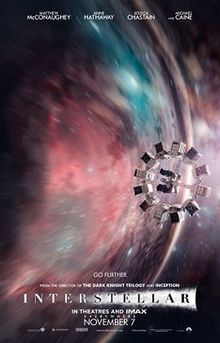 Intelligent Design
Intelligent Design
Interstellar Unwittingly Argues that Permitting Design Inferences Is Necessary to Good Science
 Well, I finally got around to seeing Interstellar, the recently released sci-fi movie about how humanity evacuates Earth to escape a deadly blight on the land and in particular on food crops. An email correspondent wrote to us here, asking if the film says or implies anything relevant to intelligent design. I think it does — but not intentionally.
Well, I finally got around to seeing Interstellar, the recently released sci-fi movie about how humanity evacuates Earth to escape a deadly blight on the land and in particular on food crops. An email correspondent wrote to us here, asking if the film says or implies anything relevant to intelligent design. I think it does — but not intentionally.
I known, I know, it’s only a movie. If you’ve seen it then I hope that the following will make perfect sense to you. If you haven’t seen it, I hope I don’t spoil it for you, because I think you’ll enjoy Interstellar. Unlike Lucy, released this past summer, it’s great science fiction.
Without saying too much about the story, yes, the origin of the wormhole that features prominently in the plot is an example of detecting design. So does detecting design in the pattern of books falling off Murph’s bookshelf, and in the movements of the second hand on her wristwatch. In each of those cases, the scientists seeking an explanation infer that there was no strictly material, unguided process at work. They conclude instead that there had to be an intelligent cause. This represents classic ID-reasoning, though the film does not explicitly state that connection.
In fact, the movie misses its own point. As with a lot of sci-fi, a major theme of Interstellar endorses scientism and transhumanism — the notions that humans can solve all our problems if we throw away belief in the supernatural and use technology to evolve to higher planes of existence. In the film, Murph (Jessica Chastain) apparently solves the mystery of the message from the books falling off the bookshelf, and the mystery of the non-random motions of her watch’s second hand, by giving up her prior belief in supernatural entities, “ghosts.” (At least that’s how the film’s scriptwriters want you to think she solved those mysteries.) She proceeds to use knowledge she gained from the intelligently designed messages imparted by these events to solve important scientific questions. In so doing, she helps to save humanity.
I think the message the movie’s creators want you to take from those scenes is that only by throwing away belief in the supernatural and relying on ourselves to make scientific advancements can we solve humanity’s problems. Ironically, though, in the same scenes, the real key to solving humanity’s problems had nothing to do with belief or disbelief in the supernatural. Rather, the key was in inferring INTELLIGENT CAUSES over material ones!
Murph realized that there was an intelligent cause behind the books falling off the bookshelves, and in the motions of the second hand of her wristwatch. (I won’t say who the intelligent cause was because that would spoil the plot.) Only after making a design inference was she able to identify and decode the intended messages.
Thus, contrary to what the movie’s creators evidently intended, the actual message of Interstellar, properly understood, is very friendly to ID. It is that, if we limit ourselves to material causes in explaining the world, we might miss some very important clues about the workings of reality. If we’re to fully understand the universe around us, good scientists must be open to inferring intelligent causes.
In Interstellar, had Murph been a scientist who was fully committed to methodological naturalism, humanity would have gone extinct.
